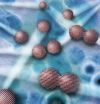(Press-News.org) Our cells breathe and digest, as does the organism as a whole. They indeed use oxygen to draw the energy contained in the nutrients they ingest, before discarding the waste, as carbon dioxide and water. Glucose is a preferred nutrient for the cells. Its digestion occurs in the cytoplasm, in the absence of oxygen, and leads to the formation of pyruvate and a small amount of energy. Pyruvate is then carried into mitochondria, the cell's power plants, for a complete burning, thus providing a maximal energetic yield.
A mediocre energetic yield in tumor cells
'As opposed to healthy cells, tumor cells produce the energy they need mainly in the cytoplasm. For reasons that are still misunderstood, they have little use for their mitochondria', notes Jean-Claude Martinou, professor at the University of Geneva, Switzerland. However, cancer cells don't seem to lack energy. They compensate the low energetic yield by an increased consumption of glucose. This strategy allows them to do without oxygen, to a large extent. By short-cutting the mitochondria, these cells would thus escape from the deleterious effects of toxic molecules, such as free radicals, produced during the cellular respiration, within the power plants.
How can the fuel pipeline be redirected to its normal pathway? 'Biologists have been attempting for more than thirty years to understand how pyruvate is transferred from the cytoplasm to the interior of the mitochondrion. We finally identified the carrier, which was named Mitochondrial Pyruvate Carrier, abbreviated MPC», details Sébastien Herzig, researcher at the Department of cell biology of the University of Geneva and first author of the article.
MCP is a universal carrier, which is almost identical from yeast to human. 'From now on, we will be able to study how the cells can modulate the activity of this carrier, according to their needs in energy', explains Jean-Claude Martinou. The next challenge will be to find a way to force the mitochondria of tumor cells to function normally, by stimulating pyruvate transport towards the interior of these power plants.
### END
The cells' petrol pump is finally identified
Researchers from the University of Geneva, Switzerland, describe how mitochondria, the cell's power plants, are supplied with fuel
2012-05-28
ELSE PRESS RELEASES FROM THIS DATE:
CWRU class earns Science magazine prize for innovation
2012-05-28
Science magazine has awarded a prize for Inquiry-Based Instruction to a Case Western Reserve University class that melds biology, computer modeling, mathematical analysis and writing.
"Dynamics of Biological Systems," taught by Biology Professor Hillel Chiel and three graduate assistants, abandons traditional lectures altogether in favor of learning by doing. The teachers call the class an example of the use of the continual improvement model in education.
In it, Chiel pairs biology majors with engineering, physics or math majors, and has them concentrate on building ...
First direct observation of oriented attachment in nanocrystal growth
2012-05-28
Through biomineralization, nature is able to produce such engineering marvels as mother of pearl, or nacre, the inner lining of abalone shells renowned for both its iridescent beauty and amazing toughness. Key to biomineralization is the phenomenon known as "oriented attachment," whereby adjacent nanoparticles connect with one another in a common crystallographic orientation. While the importance of oriented attachment to biomineral properties long has been recognized, the mechanism by which it occurs has remained a mystery. With a better understanding of oriented attachment ...
Nanoparticles seen as artificial atoms
2012-05-28
VIDEO:
Berkeley Lab researchers at the National Center for Electron Microscopy recorded real-time observations of nanocrystal growth that support the theory of nanoparticles acting like artificial atoms. This electron microscopy movie...
Click here for more information.
In the growth of crystals, do nanoparticles act as "artificial atoms" forming molecular-type building blocks that can assemble into complex structures? This is the contention of a major but controversial ...
Knowing genetic makeup may not significantly improve disease risk prediction
2012-05-28
Boston, MA —Harvard School of Public Health (HSPH) researchers have found that detailed knowledge about your genetic makeup—the interplay between genetic variants and other genetic variants, or between genetic variants and environmental risk factors—may only change your estimated disease prediction risk for three common diseases by a few percentage points, which is typically not enough to make a difference in prevention or treatment plans. It is the first study to revisit claims in previous research that including such information in risk models would eventually help doctors ...
Pivotal role for proteins -- from helping turn carbs into energy to causing devastating disease
2012-05-28
(SALT LAKE CITY)—Research into how carbohydrates are converted into energy has led to a surprising discovery with implications for the treatment of a perplexing and potentially fatal neuromuscular disorder and possibly even cancer and heart disease.
Until this study, the cause of this neuromuscular disorder was unknown. But after obtaining DNA from three families with members who have the disorder, a team led by University of Utah scientists Jared Rutter, Ph.D., associate professor of biochemistry and Carl Thummel, Ph.D., professor of human genetics, sequenced two genes ...
Discarded data may hold the key to a sharper view of molecules
2012-05-28
CORVALLIS, Ore. — There's nothing like a new pair of eyeglasses to bring fine details into sharp relief. For scientists who study the large molecules of life from proteins to DNA, the equivalent of new lenses have come in the form of an advanced method for analyzing data from X-ray crystallography experiments.
The findings, just published in the journal Science, could lead to new understanding of the molecules that drive processes in biology, medical diagnostics, nanotechnology and other fields.
Like dentists who use X-rays to find tooth decay, scientists use X-rays ...
No new neurons in the human olfactory bulb
2012-05-28
Research from Karolinska Institutet in Sweden shows that the human olfactory bulb – a structure in the brain that processes sensory input from the nose – differs from that of other mammals in that no new neurons are formed in this area after birth. The discovery, which is published in the scientific journal Neuron, is based on the age-determination of the cells using the carbon-14 method, and might explain why the human sense of smell is normally much worse than that of other animals.
"I've never been so astonished by a scientific discovery," says lead investigator Jonas ...
Gene discovery points towards new type of male contraceptive
2012-05-28
A new type of male contraceptive could be created thanks to the discovery of a key gene essential for sperm development.
The finding could lead to alternatives to conventional male contraceptives that rely on disrupting the production of hormones, such as testosterone and can cause side-effects such as irritability, mood swings and acne.
Research, led by the University of Edinburgh, has shown how a gene – Katnal1 – is critical to enable sperm to mature in the testes.
If scientists can regulate the Katnal1 gene in the testes, they could prevent sperm from maturing ...
Drug allergy discovery
2012-05-28
A research team led by the University of Melbourne and Monash University, Australia, has discovered why people can develop life-threatening allergies after receiving treatment for conditions such as epilepsy and AIDS.
The finding could lead to the development of a diagnostic test to determine drug hypersensitivity.
The study published today in the journal Nature, revealed how some drugs inadvertently target the immune system to alter how the body's immune system perceives it's own tissues, making them look foreign.
The immune system then attacks the foreign nature ...
Beetle-infested pine trees contribute to air pollution and haze in forests
2012-05-28
The hordes of bark beetles that have bored their way through more than six billion trees in the western United States and British Columbia since the 1990s do more than kill stately pine, spruce and other trees.
Results of a new study show that these pests can make trees release up to 20 times more of the organic substances that foster haze and air pollution in forested areas.
A paper reporting the findings appears today in the journal Environmental Science & Technology, published by the American Chemical Society.
Scientists Kara Huff Hartz of Southern Illinois University ...
LAST 30 PRESS RELEASES:
Study finds brain care score can predict risk of stroke across racial groups
Key lung immune cells can intensify allergic reactions
Do hormones explain why women experience more gut pain?
New materials conduct ions in solids as easily as in liquids
Breakthrough of the Year: Renewable energy begins to eclipse fossil fuel-based sources
LLM use is reshaping scientific enterprise by increasing output, reducing quality and more
Introducing LightGen, a chip for ultra-fast, ultra-efficient generative AI
Astronomers see fireworks from violent collisions around nearby star
ACC/AHA issue new guideline on managing congenital heart disease in adults
Cosmic crash caught on camera
Is talented youth nurtured the wrong way? New study shows: top performers develop differently than assumed
Ants: An untapped resource in the development of antibiotics?
Archaeologists use AI to create prehistoric video game
Mitochondria migrate toward the cell membrane in response to high glucose levels
Tiny viral switch offers hope against drug-resistant bacteria
Most parents aware of early peanut introduction guidelines, but confused about details
HPV vaccine can protect against severe lesions of the vulva and vagina
Virtual care provision and emergency department use among children and youth
Quadrivalent HPV vaccine and high-grade vulvovaginal lesions
Insights into dry eyes gained from stem cell-derived tear glands
Researchers identify 166 human pluripotent stem cell lines available for use in clinical applications
Europa Clipper instrument uniquely observed interstellar comet 3I/ATLAS
UN University Report challenges climate change as sole trigger of Syrian Civil War, exposing governance failures in drought response
Real estate investment trust (REIT) acquisition associated with hospital closure and bankruptcy
New Raman imaging system detects subtle tumor signals
Boston Children’s receives a $7.5 million grant from Aligning Research to Impact Autism (ARIA) to provide clinical research coordination for the IMPACT Network
Spray-on antibacterial coating offers new protection for plants against disease and drought
ESMT Berlin study: What makes a first offer successful in negotiations
Groundbreaking ceremony marks the beginning of CTAO-South Array construction in Chile
Why swearing makes you stronger
[Press-News.org] The cells' petrol pump is finally identifiedResearchers from the University of Geneva, Switzerland, describe how mitochondria, the cell's power plants, are supplied with fuel


